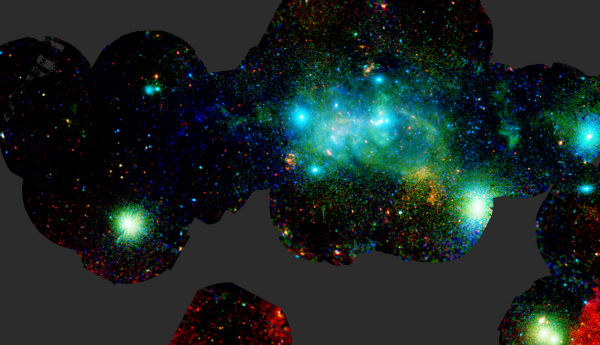Windows of Astronomy |
||
X-rays & gamma rays X-rays were famously discovered by Röntgen in 1895 and they are not absorbed much by air in a room. The depth of the atmosphere, though, is a different proposition. Above each square metre of surface on the ground there is about 10 tonnes of atmosphere, at least at sea level. X-rays have no hope of penetrating that thickness of material so X-ray astronomy seemed to be a non-starter. Indeed why bother to look, for a body as hot as the Sun should emit a negligible fraction of its radiation as X-rays. The first X-ray telescopes launched into space increased our view of the universe. The Sun does indeed emit at X-ray wavelengths, powerfully enough to be imaged. The X-rays come not from the hot photosphere we see with our eyes but from the exceedingly energetic corona that surrounds the Sun. X-rays are found to be emitted around the universe. Some sources are: hot gas (many millions of degrees) between galactic clusters, colliding galaxies and supernova remnants. X-ray flares have been seen coming from the centre of our galaxy and from close binary systems. X-rays are produced by rapidly accelerating (or decelerating) very energetic charged particles, including electrons and ions. Sources of X-rays in the universe are therefore places at extremely high temperature. The Chandra Source Catalogue release 2.0 of 2018 contains over 300,000 astrophysical X-ray sources. Any source detected by a small instrument in Earth orbit is producing a vast X-ray emission.
|
One of two MAGIC gamma ray telescopes at the Astronomical Observatory of El Roque de Los Muchachos on the island of La Palma. Photo Nik Szymanek. |
|
Gamma (γ) ray astronomy records photons at even greater energies than X-rays. The more energetic gamma rays (GeV) can reach ground-based observatories such as MAGIC on the island of La Palma or HESS in Namibia. Space craft will capture less energetic gamma rays and recent craft at the time of writing have been ESA’s INTEGRAL, the international Fermi Gamma-ray Space Telescope and NASA’s Swift telescope especially aimed at locating fast gamma ray bursts. Gamma ray bursts have been intriguing astronomers for decades. These intense bursts may last for only a hundred seconds or so. Years of detective work have located many of them to billions of light years away (and hence much earlier in the history of the universe). The intensity of the sources must be truly astronomical to produce readily detectable bursts at this distance away, the violent universe revealed. Other sources of gamma rays, and about 2000 have been identified, are often those energetic locations that also produce X-rays.
|
Looking towards the centre of our galaxy with X-ray vision. Image taken with the ESA’s XMM-Newton satellite (G. Ponti et al., 2015) |
|




